IMKT130 - Multivariate Data Analysis Methods in the Logistic Industry
VerifiedAdded on 2023/06/11
|13
|3485
|492
Report
AI Summary
This report provides a comprehensive review of multivariate statistical analysis techniques applied in the logistics industry, drawing from relevant academic journals. It explores data description methods, data mining, pattern recognition, and statistical inference procedures relevant to logistics, engineering, and transport. The study highlights the importance of data reduction techniques to manage large volumes of data and improve decision-making processes. It examines the application of these techniques in business, particularly in determining economic-financial factors related to business failure. The report also discusses the principles of effective management and optimization in logistics, emphasizing the need for creative solutions and extensive knowledge in various fields. Furthermore, it distinguishes between 'old' and 'new' logistics, focusing on cost reduction versus profit maximization, and explores different types of logistic systems and their implementation. The analysis extends to the importance of market studies in logistics, considering factors such as technological innovation, customer needs, and competitive differentiation. This document is useful for students as Desklib provides past papers and solved assignments.
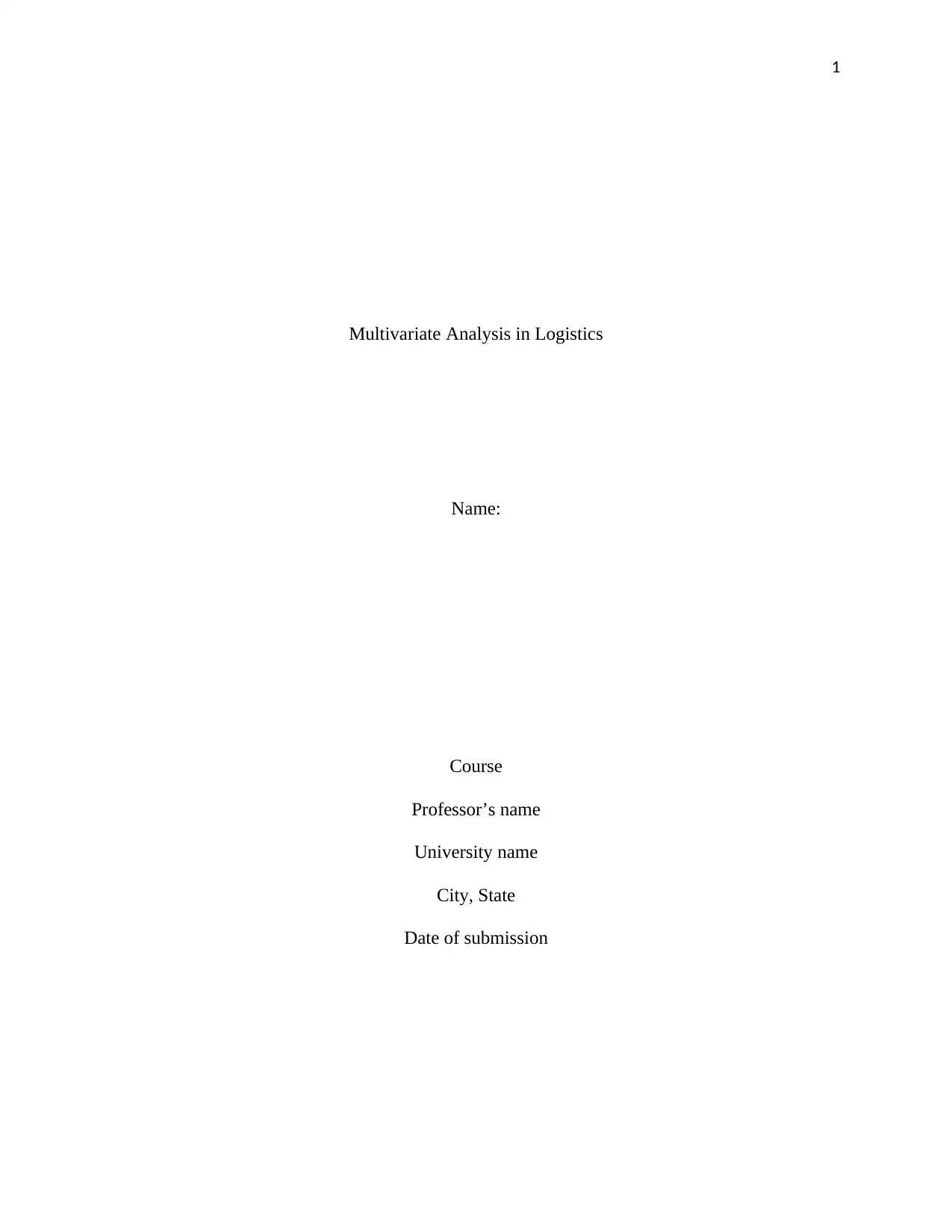
1
Multivariate Analysis in Logistics
Name:
Course
Professor’s name
University name
City, State
Date of submission
Multivariate Analysis in Logistics
Name:
Course
Professor’s name
University name
City, State
Date of submission
Paraphrase This Document
Need a fresh take? Get an instant paraphrase of this document with our AI Paraphraser
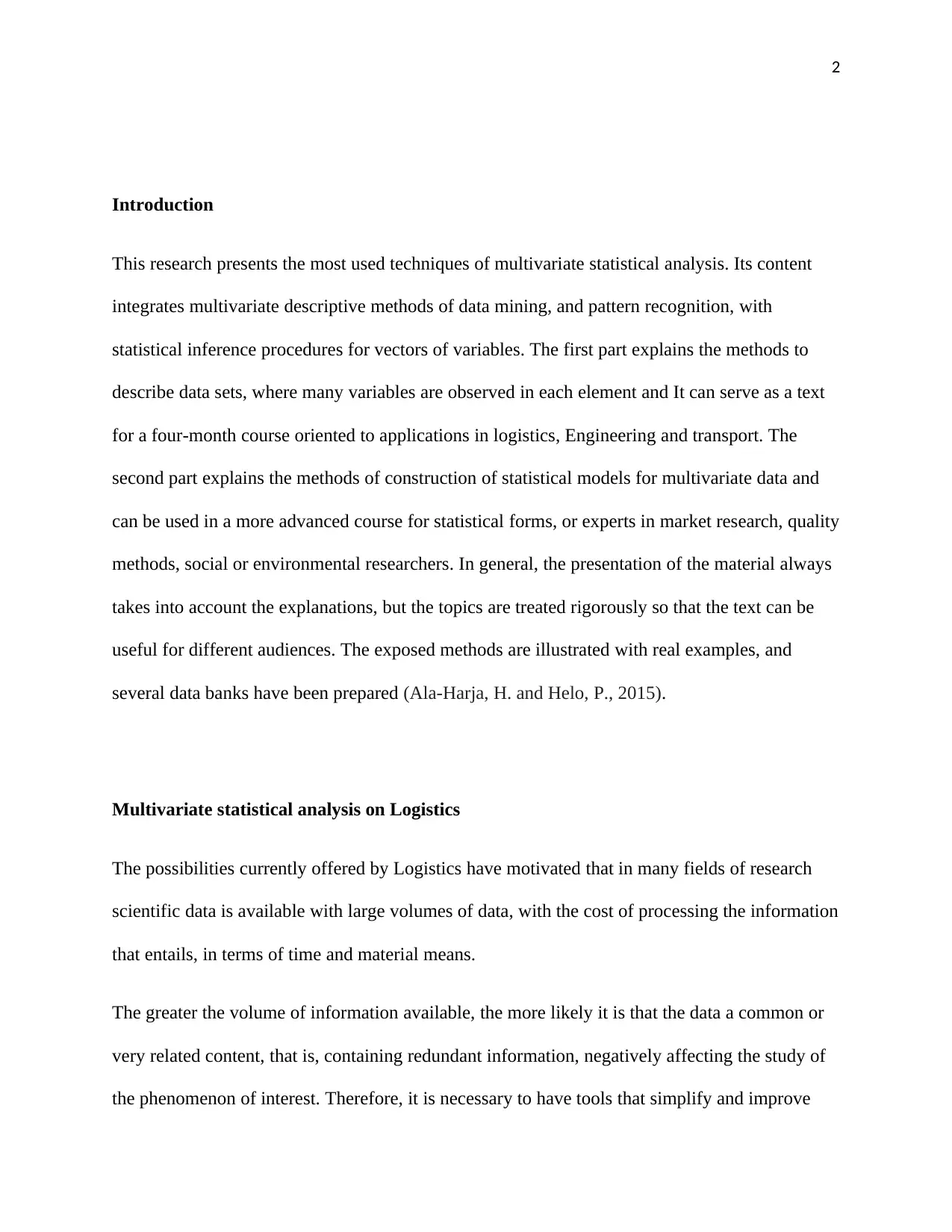
2
Introduction
This research presents the most used techniques of multivariate statistical analysis. Its content
integrates multivariate descriptive methods of data mining, and pattern recognition, with
statistical inference procedures for vectors of variables. The first part explains the methods to
describe data sets, where many variables are observed in each element and It can serve as a text
for a four-month course oriented to applications in logistics, Engineering and transport. The
second part explains the methods of construction of statistical models for multivariate data and
can be used in a more advanced course for statistical forms, or experts in market research, quality
methods, social or environmental researchers. In general, the presentation of the material always
takes into account the explanations, but the topics are treated rigorously so that the text can be
useful for different audiences. The exposed methods are illustrated with real examples, and
several data banks have been prepared (Ala-Harja, H. and Helo, P., 2015).
Multivariate statistical analysis on Logistics
The possibilities currently offered by Logistics have motivated that in many fields of research
scientific data is available with large volumes of data, with the cost of processing the information
that entails, in terms of time and material means.
The greater the volume of information available, the more likely it is that the data a common or
very related content, that is, containing redundant information, negatively affecting the study of
the phenomenon of interest. Therefore, it is necessary to have tools that simplify and improve
Introduction
This research presents the most used techniques of multivariate statistical analysis. Its content
integrates multivariate descriptive methods of data mining, and pattern recognition, with
statistical inference procedures for vectors of variables. The first part explains the methods to
describe data sets, where many variables are observed in each element and It can serve as a text
for a four-month course oriented to applications in logistics, Engineering and transport. The
second part explains the methods of construction of statistical models for multivariate data and
can be used in a more advanced course for statistical forms, or experts in market research, quality
methods, social or environmental researchers. In general, the presentation of the material always
takes into account the explanations, but the topics are treated rigorously so that the text can be
useful for different audiences. The exposed methods are illustrated with real examples, and
several data banks have been prepared (Ala-Harja, H. and Helo, P., 2015).
Multivariate statistical analysis on Logistics
The possibilities currently offered by Logistics have motivated that in many fields of research
scientific data is available with large volumes of data, with the cost of processing the information
that entails, in terms of time and material means.
The greater the volume of information available, the more likely it is that the data a common or
very related content, that is, containing redundant information, negatively affecting the study of
the phenomenon of interest. Therefore, it is necessary to have tools that simplify and improve
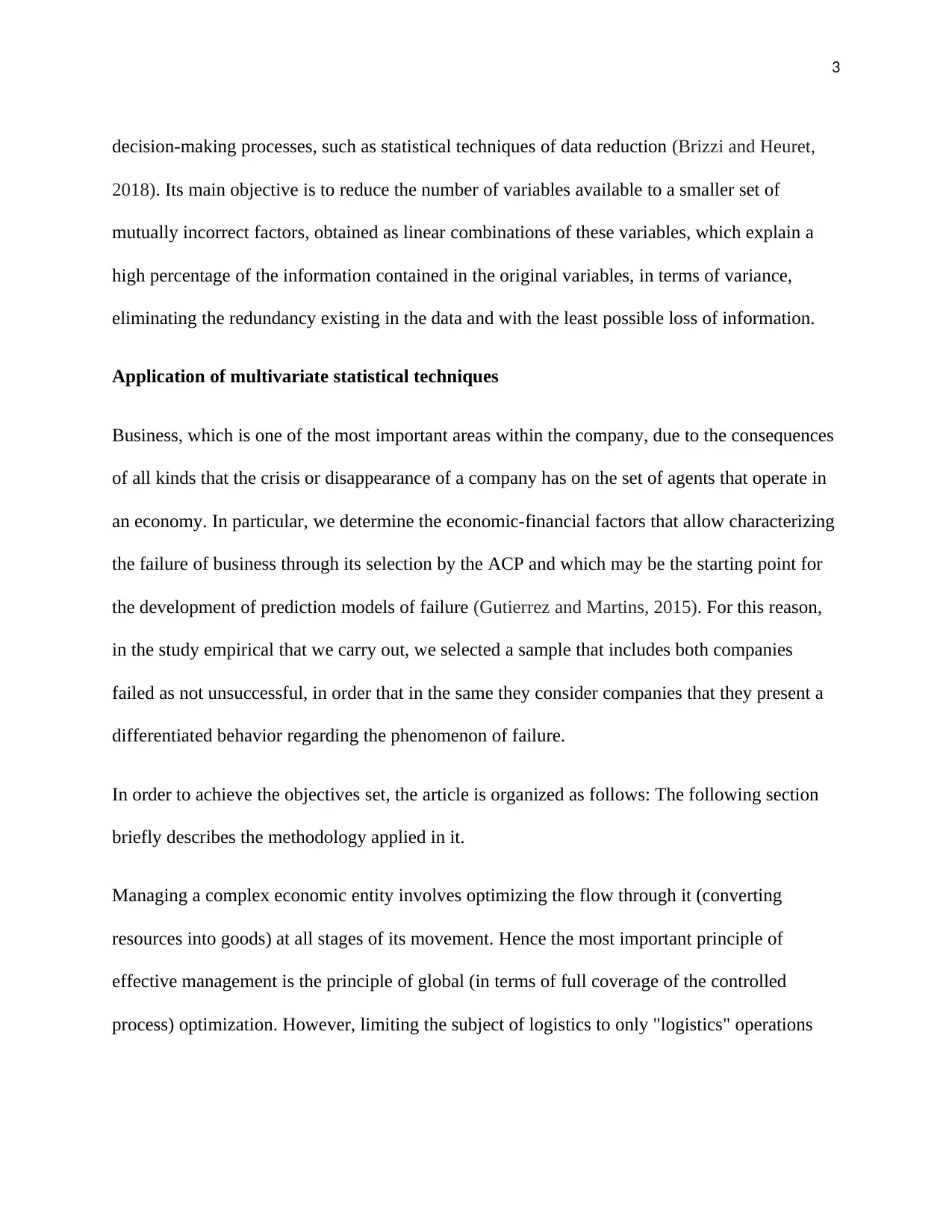
3
decision-making processes, such as statistical techniques of data reduction (Brizzi and Heuret,
2018). Its main objective is to reduce the number of variables available to a smaller set of
mutually incorrect factors, obtained as linear combinations of these variables, which explain a
high percentage of the information contained in the original variables, in terms of variance,
eliminating the redundancy existing in the data and with the least possible loss of information.
Application of multivariate statistical techniques
Business, which is one of the most important areas within the company, due to the consequences
of all kinds that the crisis or disappearance of a company has on the set of agents that operate in
an economy. In particular, we determine the economic-financial factors that allow characterizing
the failure of business through its selection by the ACP and which may be the starting point for
the development of prediction models of failure (Gutierrez and Martins, 2015). For this reason,
in the study empirical that we carry out, we selected a sample that includes both companies
failed as not unsuccessful, in order that in the same they consider companies that they present a
differentiated behavior regarding the phenomenon of failure.
In order to achieve the objectives set, the article is organized as follows: The following section
briefly describes the methodology applied in it.
Managing a complex economic entity involves optimizing the flow through it (converting
resources into goods) at all stages of its movement. Hence the most important principle of
effective management is the principle of global (in terms of full coverage of the controlled
process) optimization. However, limiting the subject of logistics to only "logistics" operations
decision-making processes, such as statistical techniques of data reduction (Brizzi and Heuret,
2018). Its main objective is to reduce the number of variables available to a smaller set of
mutually incorrect factors, obtained as linear combinations of these variables, which explain a
high percentage of the information contained in the original variables, in terms of variance,
eliminating the redundancy existing in the data and with the least possible loss of information.
Application of multivariate statistical techniques
Business, which is one of the most important areas within the company, due to the consequences
of all kinds that the crisis or disappearance of a company has on the set of agents that operate in
an economy. In particular, we determine the economic-financial factors that allow characterizing
the failure of business through its selection by the ACP and which may be the starting point for
the development of prediction models of failure (Gutierrez and Martins, 2015). For this reason,
in the study empirical that we carry out, we selected a sample that includes both companies
failed as not unsuccessful, in order that in the same they consider companies that they present a
differentiated behavior regarding the phenomenon of failure.
In order to achieve the objectives set, the article is organized as follows: The following section
briefly describes the methodology applied in it.
Managing a complex economic entity involves optimizing the flow through it (converting
resources into goods) at all stages of its movement. Hence the most important principle of
effective management is the principle of global (in terms of full coverage of the controlled
process) optimization. However, limiting the subject of logistics to only "logistics" operations
⊘ This is a preview!⊘
Do you want full access?
Subscribe today to unlock all pages.

Trusted by 1+ million students worldwide
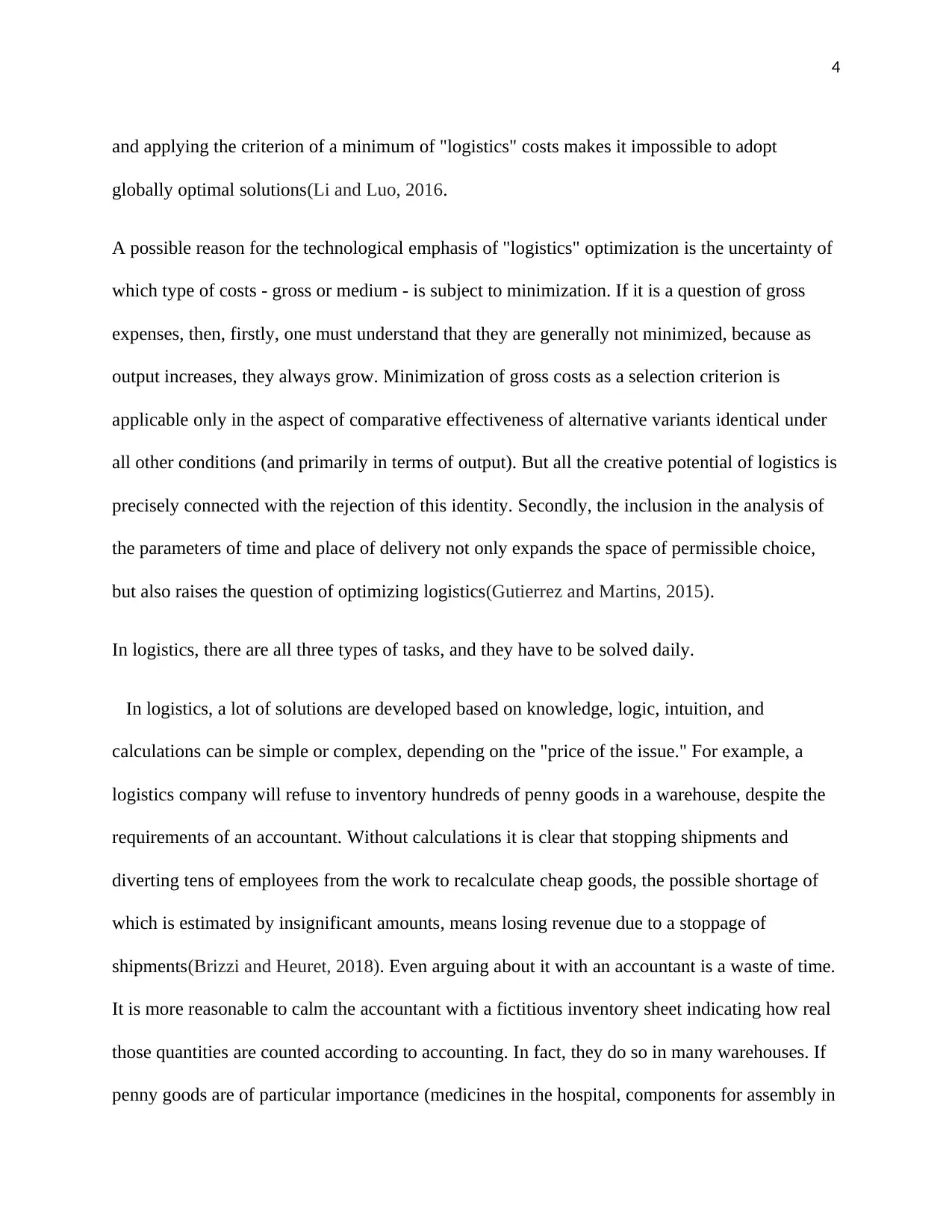
4
and applying the criterion of a minimum of "logistics" costs makes it impossible to adopt
globally optimal solutions(Li and Luo, 2016.
A possible reason for the technological emphasis of "logistics" optimization is the uncertainty of
which type of costs - gross or medium - is subject to minimization. If it is a question of gross
expenses, then, firstly, one must understand that they are generally not minimized, because as
output increases, they always grow. Minimization of gross costs as a selection criterion is
applicable only in the aspect of comparative effectiveness of alternative variants identical under
all other conditions (and primarily in terms of output). But all the creative potential of logistics is
precisely connected with the rejection of this identity. Secondly, the inclusion in the analysis of
the parameters of time and place of delivery not only expands the space of permissible choice,
but also raises the question of optimizing logistics(Gutierrez and Martins, 2015).
In logistics, there are all three types of tasks, and they have to be solved daily.
In logistics, a lot of solutions are developed based on knowledge, logic, intuition, and
calculations can be simple or complex, depending on the "price of the issue." For example, a
logistics company will refuse to inventory hundreds of penny goods in a warehouse, despite the
requirements of an accountant. Without calculations it is clear that stopping shipments and
diverting tens of employees from the work to recalculate cheap goods, the possible shortage of
which is estimated by insignificant amounts, means losing revenue due to a stoppage of
shipments(Brizzi and Heuret, 2018). Even arguing about it with an accountant is a waste of time.
It is more reasonable to calm the accountant with a fictitious inventory sheet indicating how real
those quantities are counted according to accounting. In fact, they do so in many warehouses. If
penny goods are of particular importance (medicines in the hospital, components for assembly in
and applying the criterion of a minimum of "logistics" costs makes it impossible to adopt
globally optimal solutions(Li and Luo, 2016.
A possible reason for the technological emphasis of "logistics" optimization is the uncertainty of
which type of costs - gross or medium - is subject to minimization. If it is a question of gross
expenses, then, firstly, one must understand that they are generally not minimized, because as
output increases, they always grow. Minimization of gross costs as a selection criterion is
applicable only in the aspect of comparative effectiveness of alternative variants identical under
all other conditions (and primarily in terms of output). But all the creative potential of logistics is
precisely connected with the rejection of this identity. Secondly, the inclusion in the analysis of
the parameters of time and place of delivery not only expands the space of permissible choice,
but also raises the question of optimizing logistics(Gutierrez and Martins, 2015).
In logistics, there are all three types of tasks, and they have to be solved daily.
In logistics, a lot of solutions are developed based on knowledge, logic, intuition, and
calculations can be simple or complex, depending on the "price of the issue." For example, a
logistics company will refuse to inventory hundreds of penny goods in a warehouse, despite the
requirements of an accountant. Without calculations it is clear that stopping shipments and
diverting tens of employees from the work to recalculate cheap goods, the possible shortage of
which is estimated by insignificant amounts, means losing revenue due to a stoppage of
shipments(Brizzi and Heuret, 2018). Even arguing about it with an accountant is a waste of time.
It is more reasonable to calm the accountant with a fictitious inventory sheet indicating how real
those quantities are counted according to accounting. In fact, they do so in many warehouses. If
penny goods are of particular importance (medicines in the hospital, components for assembly in
Paraphrase This Document
Need a fresh take? Get an instant paraphrase of this document with our AI Paraphraser
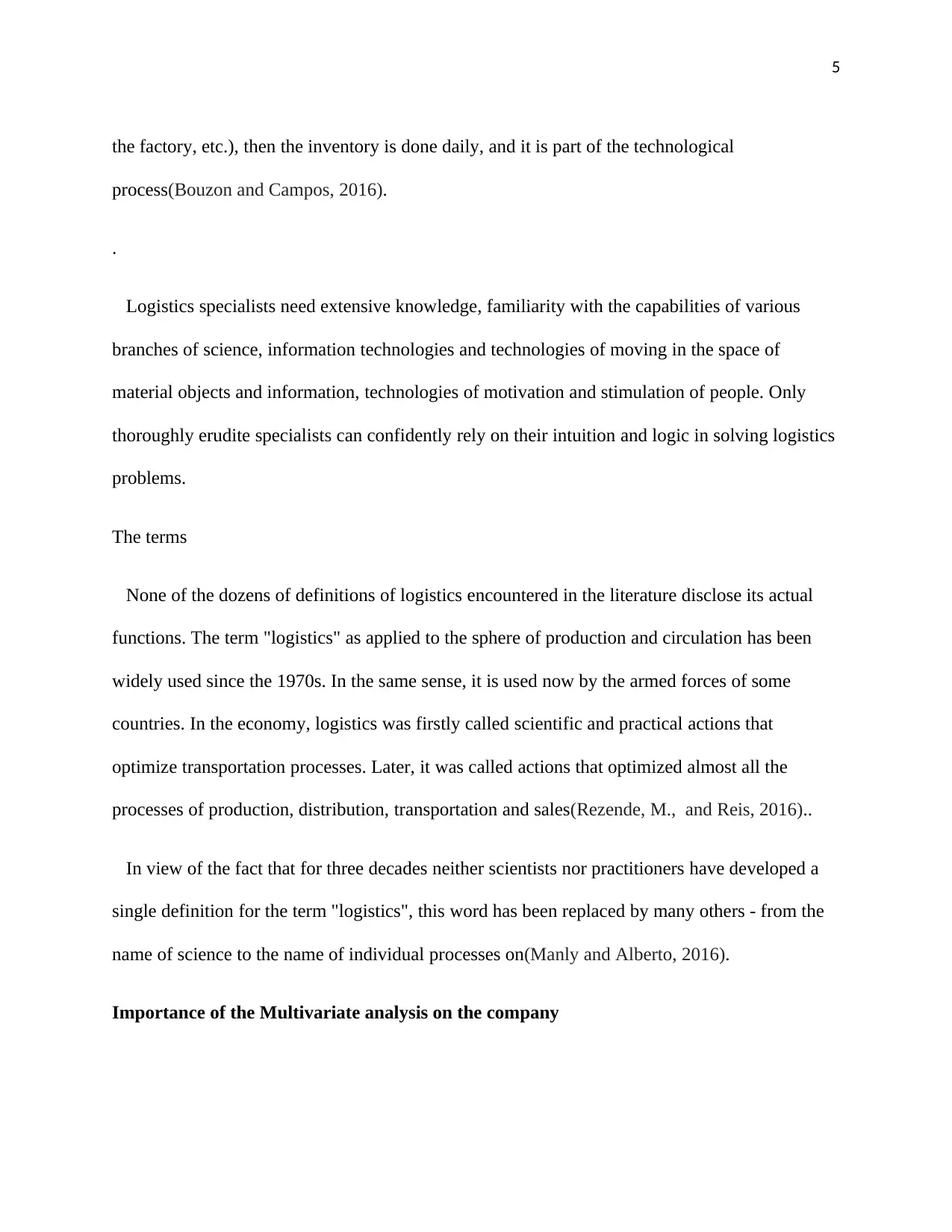
5
the factory, etc.), then the inventory is done daily, and it is part of the technological
process(Bouzon and Campos, 2016).
.
Logistics specialists need extensive knowledge, familiarity with the capabilities of various
branches of science, information technologies and technologies of moving in the space of
material objects and information, technologies of motivation and stimulation of people. Only
thoroughly erudite specialists can confidently rely on their intuition and logic in solving logistics
problems.
The terms
None of the dozens of definitions of logistics encountered in the literature disclose its actual
functions. The term "logistics" as applied to the sphere of production and circulation has been
widely used since the 1970s. In the same sense, it is used now by the armed forces of some
countries. In the economy, logistics was firstly called scientific and practical actions that
optimize transportation processes. Later, it was called actions that optimized almost all the
processes of production, distribution, transportation and sales(Rezende, M., and Reis, 2016)..
In view of the fact that for three decades neither scientists nor practitioners have developed a
single definition for the term "logistics", this word has been replaced by many others - from the
name of science to the name of individual processes on(Manly and Alberto, 2016).
Importance of the Multivariate analysis on the company
the factory, etc.), then the inventory is done daily, and it is part of the technological
process(Bouzon and Campos, 2016).
.
Logistics specialists need extensive knowledge, familiarity with the capabilities of various
branches of science, information technologies and technologies of moving in the space of
material objects and information, technologies of motivation and stimulation of people. Only
thoroughly erudite specialists can confidently rely on their intuition and logic in solving logistics
problems.
The terms
None of the dozens of definitions of logistics encountered in the literature disclose its actual
functions. The term "logistics" as applied to the sphere of production and circulation has been
widely used since the 1970s. In the same sense, it is used now by the armed forces of some
countries. In the economy, logistics was firstly called scientific and practical actions that
optimize transportation processes. Later, it was called actions that optimized almost all the
processes of production, distribution, transportation and sales(Rezende, M., and Reis, 2016)..
In view of the fact that for three decades neither scientists nor practitioners have developed a
single definition for the term "logistics", this word has been replaced by many others - from the
name of science to the name of individual processes on(Manly and Alberto, 2016).
Importance of the Multivariate analysis on the company
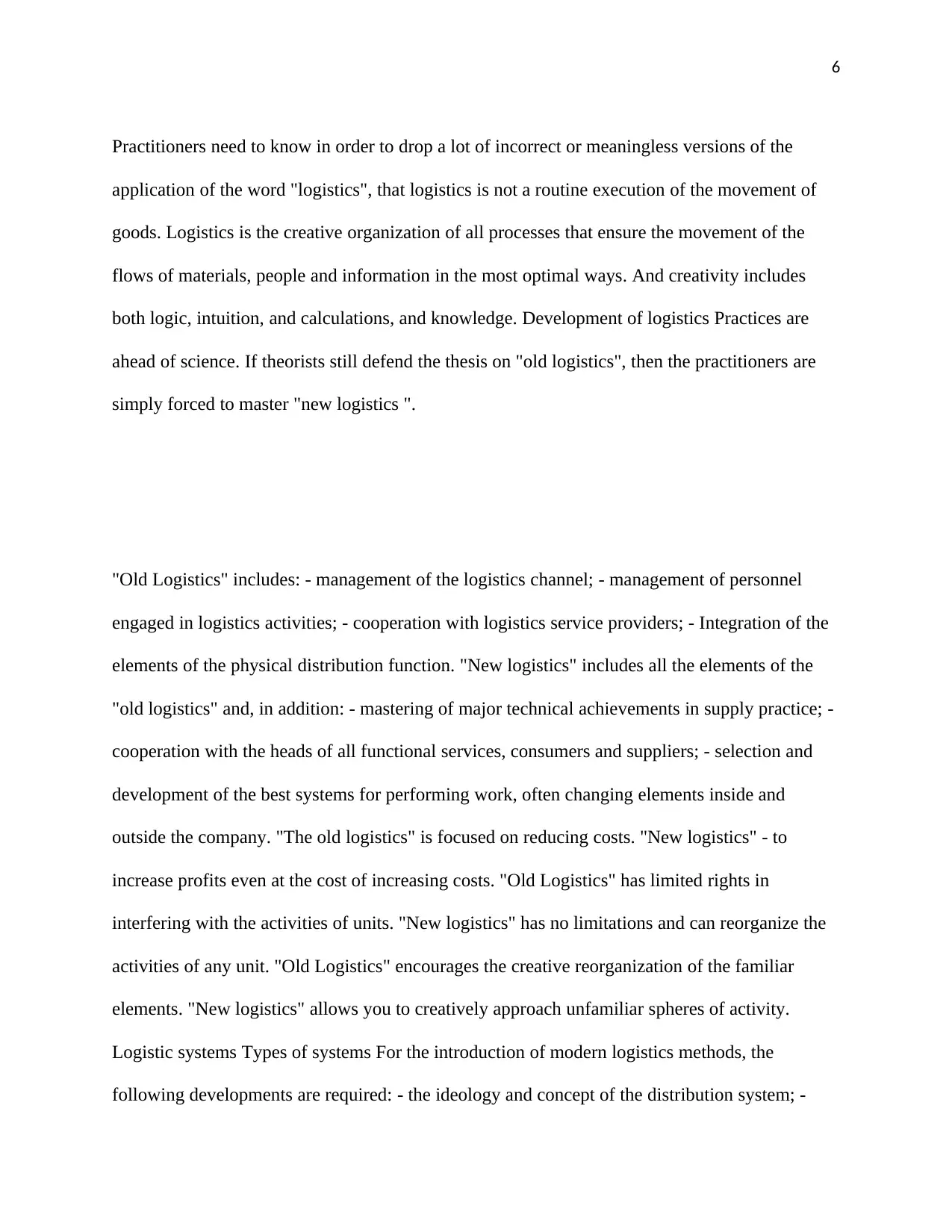
6
Practitioners need to know in order to drop a lot of incorrect or meaningless versions of the
application of the word "logistics", that logistics is not a routine execution of the movement of
goods. Logistics is the creative organization of all processes that ensure the movement of the
flows of materials, people and information in the most optimal ways. And creativity includes
both logic, intuition, and calculations, and knowledge. Development of logistics Practices are
ahead of science. If theorists still defend the thesis on "old logistics", then the practitioners are
simply forced to master "new logistics ".
"Old Logistics" includes: - management of the logistics channel; - management of personnel
engaged in logistics activities; - cooperation with logistics service providers; - Integration of the
elements of the physical distribution function. "New logistics" includes all the elements of the
"old logistics" and, in addition: - mastering of major technical achievements in supply practice; -
cooperation with the heads of all functional services, consumers and suppliers; - selection and
development of the best systems for performing work, often changing elements inside and
outside the company. "The old logistics" is focused on reducing costs. "New logistics" - to
increase profits even at the cost of increasing costs. "Old Logistics" has limited rights in
interfering with the activities of units. "New logistics" has no limitations and can reorganize the
activities of any unit. "Old Logistics" encourages the creative reorganization of the familiar
elements. "New logistics" allows you to creatively approach unfamiliar spheres of activity.
Logistic systems Types of systems For the introduction of modern logistics methods, the
following developments are required: - the ideology and concept of the distribution system; -
Practitioners need to know in order to drop a lot of incorrect or meaningless versions of the
application of the word "logistics", that logistics is not a routine execution of the movement of
goods. Logistics is the creative organization of all processes that ensure the movement of the
flows of materials, people and information in the most optimal ways. And creativity includes
both logic, intuition, and calculations, and knowledge. Development of logistics Practices are
ahead of science. If theorists still defend the thesis on "old logistics", then the practitioners are
simply forced to master "new logistics ".
"Old Logistics" includes: - management of the logistics channel; - management of personnel
engaged in logistics activities; - cooperation with logistics service providers; - Integration of the
elements of the physical distribution function. "New logistics" includes all the elements of the
"old logistics" and, in addition: - mastering of major technical achievements in supply practice; -
cooperation with the heads of all functional services, consumers and suppliers; - selection and
development of the best systems for performing work, often changing elements inside and
outside the company. "The old logistics" is focused on reducing costs. "New logistics" - to
increase profits even at the cost of increasing costs. "Old Logistics" has limited rights in
interfering with the activities of units. "New logistics" has no limitations and can reorganize the
activities of any unit. "Old Logistics" encourages the creative reorganization of the familiar
elements. "New logistics" allows you to creatively approach unfamiliar spheres of activity.
Logistic systems Types of systems For the introduction of modern logistics methods, the
following developments are required: - the ideology and concept of the distribution system; -
⊘ This is a preview!⊘
Do you want full access?
Subscribe today to unlock all pages.

Trusted by 1+ million students worldwide
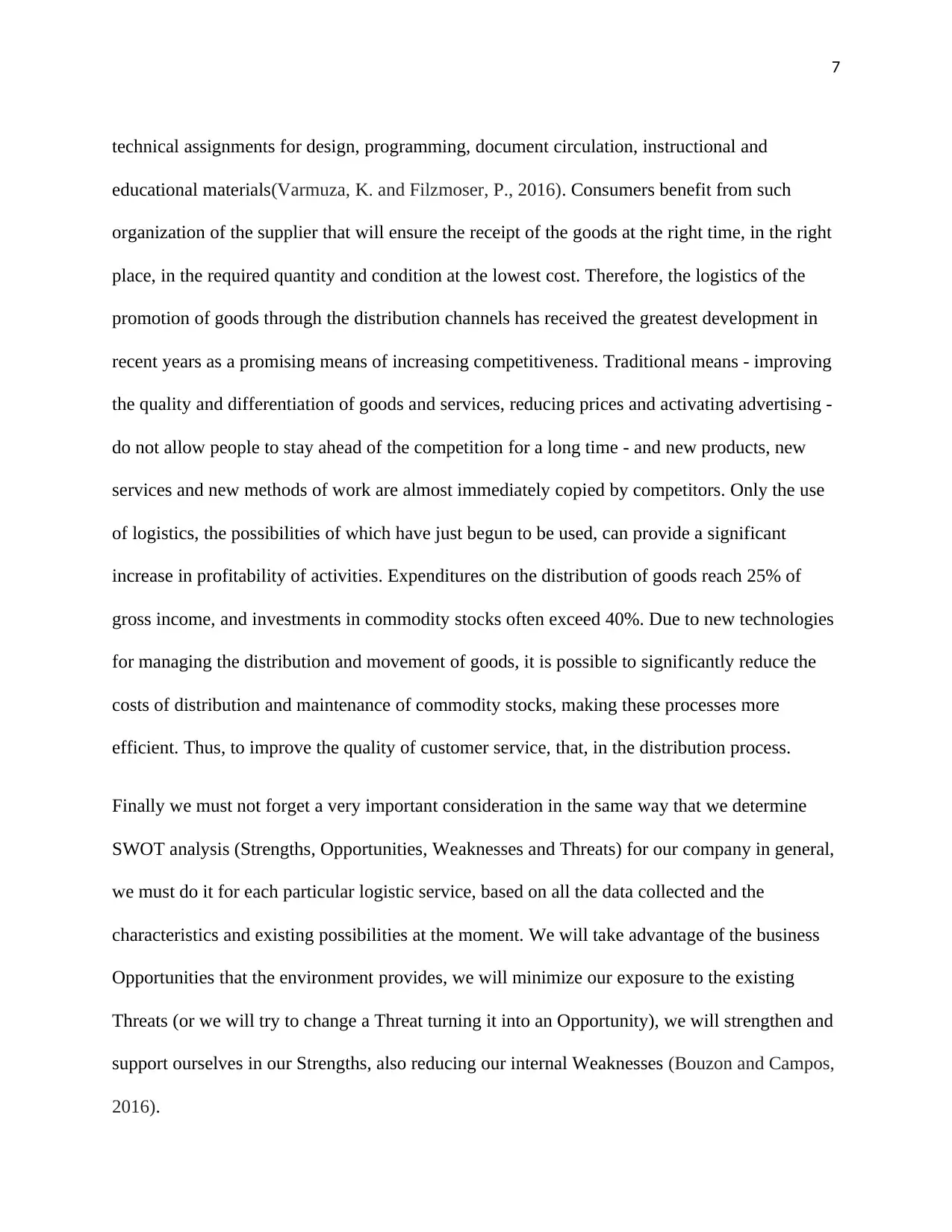
7
technical assignments for design, programming, document circulation, instructional and
educational materials(Varmuza, K. and Filzmoser, P., 2016). Consumers benefit from such
organization of the supplier that will ensure the receipt of the goods at the right time, in the right
place, in the required quantity and condition at the lowest cost. Therefore, the logistics of the
promotion of goods through the distribution channels has received the greatest development in
recent years as a promising means of increasing competitiveness. Traditional means - improving
the quality and differentiation of goods and services, reducing prices and activating advertising -
do not allow people to stay ahead of the competition for a long time - and new products, new
services and new methods of work are almost immediately copied by competitors. Only the use
of logistics, the possibilities of which have just begun to be used, can provide a significant
increase in profitability of activities. Expenditures on the distribution of goods reach 25% of
gross income, and investments in commodity stocks often exceed 40%. Due to new technologies
for managing the distribution and movement of goods, it is possible to significantly reduce the
costs of distribution and maintenance of commodity stocks, making these processes more
efficient. Thus, to improve the quality of customer service, that, in the distribution process.
Finally we must not forget a very important consideration in the same way that we determine
SWOT analysis (Strengths, Opportunities, Weaknesses and Threats) for our company in general,
we must do it for each particular logistic service, based on all the data collected and the
characteristics and existing possibilities at the moment. We will take advantage of the business
Opportunities that the environment provides, we will minimize our exposure to the existing
Threats (or we will try to change a Threat turning it into an Opportunity), we will strengthen and
support ourselves in our Strengths, also reducing our internal Weaknesses (Bouzon and Campos,
2016).
technical assignments for design, programming, document circulation, instructional and
educational materials(Varmuza, K. and Filzmoser, P., 2016). Consumers benefit from such
organization of the supplier that will ensure the receipt of the goods at the right time, in the right
place, in the required quantity and condition at the lowest cost. Therefore, the logistics of the
promotion of goods through the distribution channels has received the greatest development in
recent years as a promising means of increasing competitiveness. Traditional means - improving
the quality and differentiation of goods and services, reducing prices and activating advertising -
do not allow people to stay ahead of the competition for a long time - and new products, new
services and new methods of work are almost immediately copied by competitors. Only the use
of logistics, the possibilities of which have just begun to be used, can provide a significant
increase in profitability of activities. Expenditures on the distribution of goods reach 25% of
gross income, and investments in commodity stocks often exceed 40%. Due to new technologies
for managing the distribution and movement of goods, it is possible to significantly reduce the
costs of distribution and maintenance of commodity stocks, making these processes more
efficient. Thus, to improve the quality of customer service, that, in the distribution process.
Finally we must not forget a very important consideration in the same way that we determine
SWOT analysis (Strengths, Opportunities, Weaknesses and Threats) for our company in general,
we must do it for each particular logistic service, based on all the data collected and the
characteristics and existing possibilities at the moment. We will take advantage of the business
Opportunities that the environment provides, we will minimize our exposure to the existing
Threats (or we will try to change a Threat turning it into an Opportunity), we will strengthen and
support ourselves in our Strengths, also reducing our internal Weaknesses (Bouzon and Campos,
2016).
Paraphrase This Document
Need a fresh take? Get an instant paraphrase of this document with our AI Paraphraser
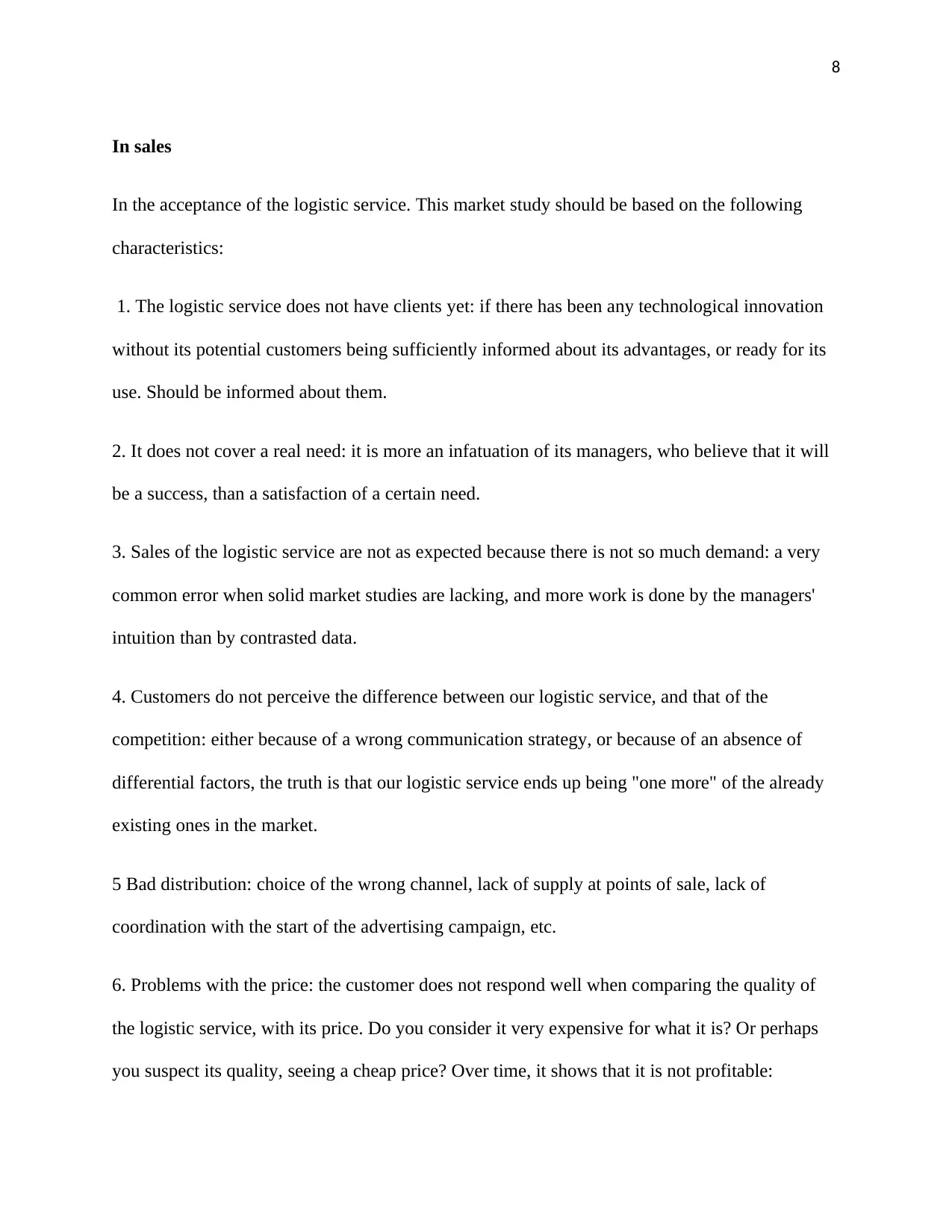
8
In sales
In the acceptance of the logistic service. This market study should be based on the following
characteristics:
1. The logistic service does not have clients yet: if there has been any technological innovation
without its potential customers being sufficiently informed about its advantages, or ready for its
use. Should be informed about them.
2. It does not cover a real need: it is more an infatuation of its managers, who believe that it will
be a success, than a satisfaction of a certain need.
3. Sales of the logistic service are not as expected because there is not so much demand: a very
common error when solid market studies are lacking, and more work is done by the managers'
intuition than by contrasted data.
4. Customers do not perceive the difference between our logistic service, and that of the
competition: either because of a wrong communication strategy, or because of an absence of
differential factors, the truth is that our logistic service ends up being "one more" of the already
existing ones in the market.
5 Bad distribution: choice of the wrong channel, lack of supply at points of sale, lack of
coordination with the start of the advertising campaign, etc.
6. Problems with the price: the customer does not respond well when comparing the quality of
the logistic service, with its price. Do you consider it very expensive for what it is? Or perhaps
you suspect its quality, seeing a cheap price? Over time, it shows that it is not profitable:
In sales
In the acceptance of the logistic service. This market study should be based on the following
characteristics:
1. The logistic service does not have clients yet: if there has been any technological innovation
without its potential customers being sufficiently informed about its advantages, or ready for its
use. Should be informed about them.
2. It does not cover a real need: it is more an infatuation of its managers, who believe that it will
be a success, than a satisfaction of a certain need.
3. Sales of the logistic service are not as expected because there is not so much demand: a very
common error when solid market studies are lacking, and more work is done by the managers'
intuition than by contrasted data.
4. Customers do not perceive the difference between our logistic service, and that of the
competition: either because of a wrong communication strategy, or because of an absence of
differential factors, the truth is that our logistic service ends up being "one more" of the already
existing ones in the market.
5 Bad distribution: choice of the wrong channel, lack of supply at points of sale, lack of
coordination with the start of the advertising campaign, etc.
6. Problems with the price: the customer does not respond well when comparing the quality of
the logistic service, with its price. Do you consider it very expensive for what it is? Or perhaps
you suspect its quality, seeing a cheap price? Over time, it shows that it is not profitable:
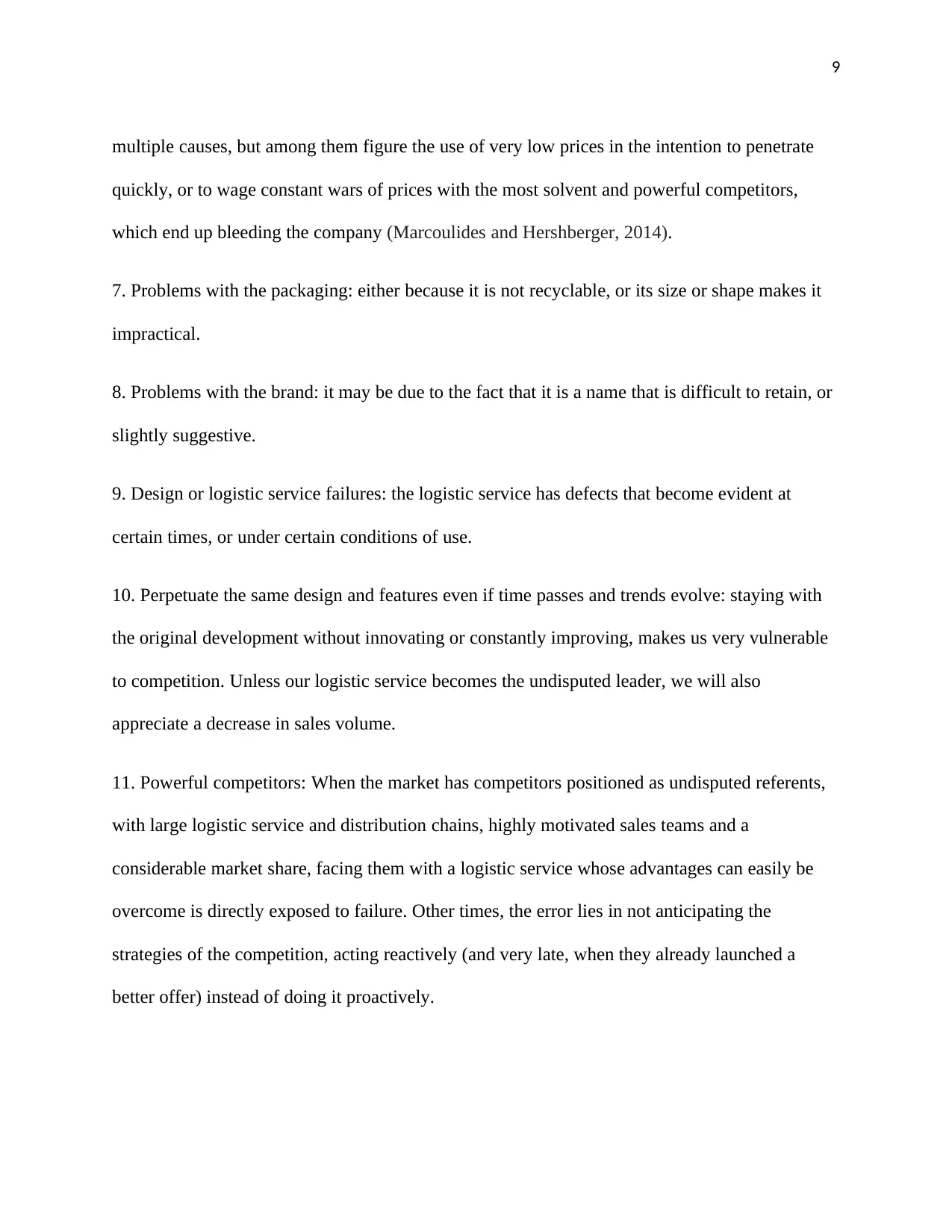
9
multiple causes, but among them figure the use of very low prices in the intention to penetrate
quickly, or to wage constant wars of prices with the most solvent and powerful competitors,
which end up bleeding the company (Marcoulides and Hershberger, 2014).
7. Problems with the packaging: either because it is not recyclable, or its size or shape makes it
impractical.
8. Problems with the brand: it may be due to the fact that it is a name that is difficult to retain, or
slightly suggestive.
9. Design or logistic service failures: the logistic service has defects that become evident at
certain times, or under certain conditions of use.
10. Perpetuate the same design and features even if time passes and trends evolve: staying with
the original development without innovating or constantly improving, makes us very vulnerable
to competition. Unless our logistic service becomes the undisputed leader, we will also
appreciate a decrease in sales volume.
11. Powerful competitors: When the market has competitors positioned as undisputed referents,
with large logistic service and distribution chains, highly motivated sales teams and a
considerable market share, facing them with a logistic service whose advantages can easily be
overcome is directly exposed to failure. Other times, the error lies in not anticipating the
strategies of the competition, acting reactively (and very late, when they already launched a
better offer) instead of doing it proactively.
multiple causes, but among them figure the use of very low prices in the intention to penetrate
quickly, or to wage constant wars of prices with the most solvent and powerful competitors,
which end up bleeding the company (Marcoulides and Hershberger, 2014).
7. Problems with the packaging: either because it is not recyclable, or its size or shape makes it
impractical.
8. Problems with the brand: it may be due to the fact that it is a name that is difficult to retain, or
slightly suggestive.
9. Design or logistic service failures: the logistic service has defects that become evident at
certain times, or under certain conditions of use.
10. Perpetuate the same design and features even if time passes and trends evolve: staying with
the original development without innovating or constantly improving, makes us very vulnerable
to competition. Unless our logistic service becomes the undisputed leader, we will also
appreciate a decrease in sales volume.
11. Powerful competitors: When the market has competitors positioned as undisputed referents,
with large logistic service and distribution chains, highly motivated sales teams and a
considerable market share, facing them with a logistic service whose advantages can easily be
overcome is directly exposed to failure. Other times, the error lies in not anticipating the
strategies of the competition, acting reactively (and very late, when they already launched a
better offer) instead of doing it proactively.
⊘ This is a preview!⊘
Do you want full access?
Subscribe today to unlock all pages.

Trusted by 1+ million students worldwide
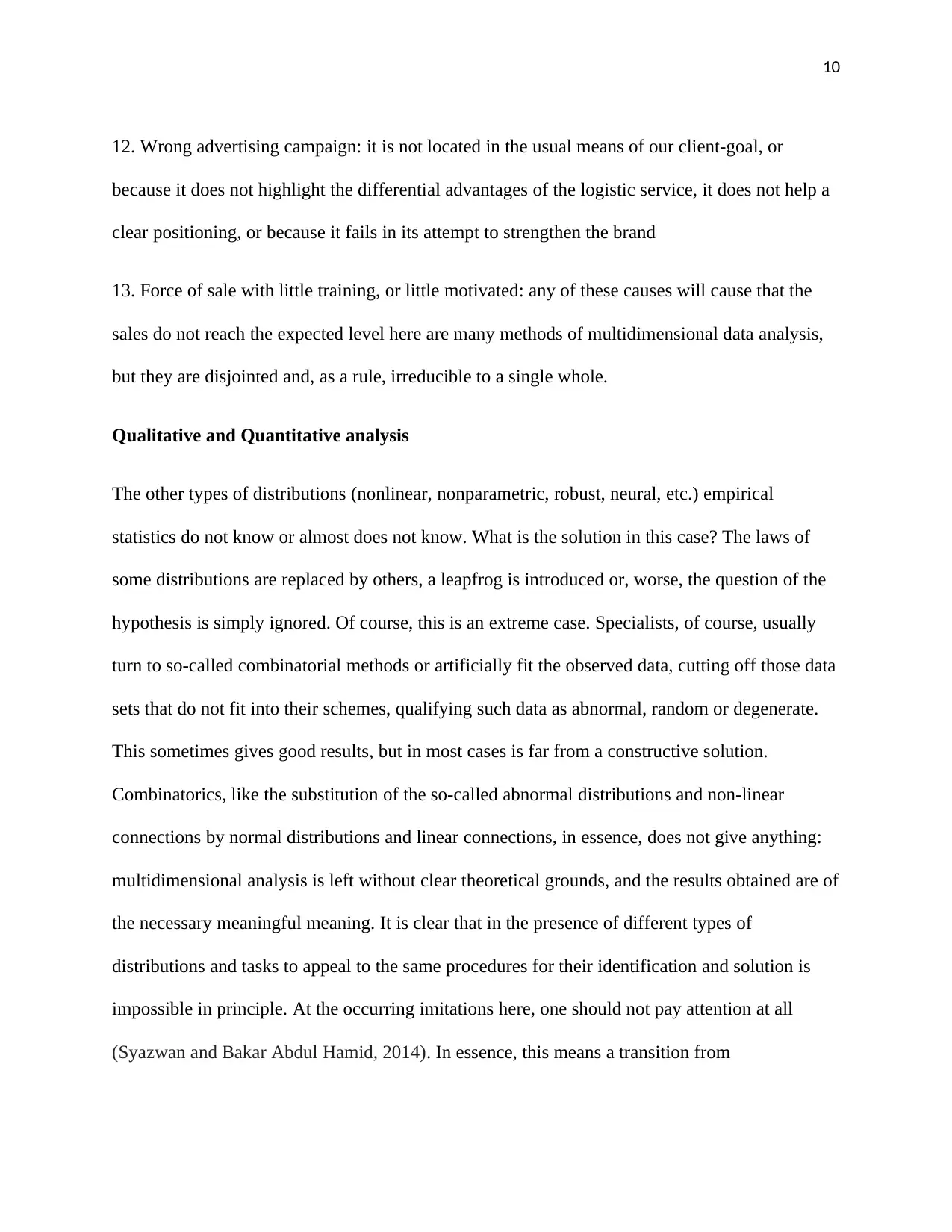
10
12. Wrong advertising campaign: it is not located in the usual means of our client-goal, or
because it does not highlight the differential advantages of the logistic service, it does not help a
clear positioning, or because it fails in its attempt to strengthen the brand
13. Force of sale with little training, or little motivated: any of these causes will cause that the
sales do not reach the expected level here are many methods of multidimensional data analysis,
but they are disjointed and, as a rule, irreducible to a single whole.
Qualitative and Quantitative analysis
The other types of distributions (nonlinear, nonparametric, robust, neural, etc.) empirical
statistics do not know or almost does not know. What is the solution in this case? The laws of
some distributions are replaced by others, a leapfrog is introduced or, worse, the question of the
hypothesis is simply ignored. Of course, this is an extreme case. Specialists, of course, usually
turn to so-called combinatorial methods or artificially fit the observed data, cutting off those data
sets that do not fit into their schemes, qualifying such data as abnormal, random or degenerate.
This sometimes gives good results, but in most cases is far from a constructive solution.
Combinatorics, like the substitution of the so-called abnormal distributions and non-linear
connections by normal distributions and linear connections, in essence, does not give anything:
multidimensional analysis is left without clear theoretical grounds, and the results obtained are of
the necessary meaningful meaning. It is clear that in the presence of different types of
distributions and tasks to appeal to the same procedures for their identification and solution is
impossible in principle. At the occurring imitations here, one should not pay attention at all
(Syazwan and Bakar Abdul Hamid, 2014). In essence, this means a transition from
12. Wrong advertising campaign: it is not located in the usual means of our client-goal, or
because it does not highlight the differential advantages of the logistic service, it does not help a
clear positioning, or because it fails in its attempt to strengthen the brand
13. Force of sale with little training, or little motivated: any of these causes will cause that the
sales do not reach the expected level here are many methods of multidimensional data analysis,
but they are disjointed and, as a rule, irreducible to a single whole.
Qualitative and Quantitative analysis
The other types of distributions (nonlinear, nonparametric, robust, neural, etc.) empirical
statistics do not know or almost does not know. What is the solution in this case? The laws of
some distributions are replaced by others, a leapfrog is introduced or, worse, the question of the
hypothesis is simply ignored. Of course, this is an extreme case. Specialists, of course, usually
turn to so-called combinatorial methods or artificially fit the observed data, cutting off those data
sets that do not fit into their schemes, qualifying such data as abnormal, random or degenerate.
This sometimes gives good results, but in most cases is far from a constructive solution.
Combinatorics, like the substitution of the so-called abnormal distributions and non-linear
connections by normal distributions and linear connections, in essence, does not give anything:
multidimensional analysis is left without clear theoretical grounds, and the results obtained are of
the necessary meaningful meaning. It is clear that in the presence of different types of
distributions and tasks to appeal to the same procedures for their identification and solution is
impossible in principle. At the occurring imitations here, one should not pay attention at all
(Syazwan and Bakar Abdul Hamid, 2014). In essence, this means a transition from
Paraphrase This Document
Need a fresh take? Get an instant paraphrase of this document with our AI Paraphraser
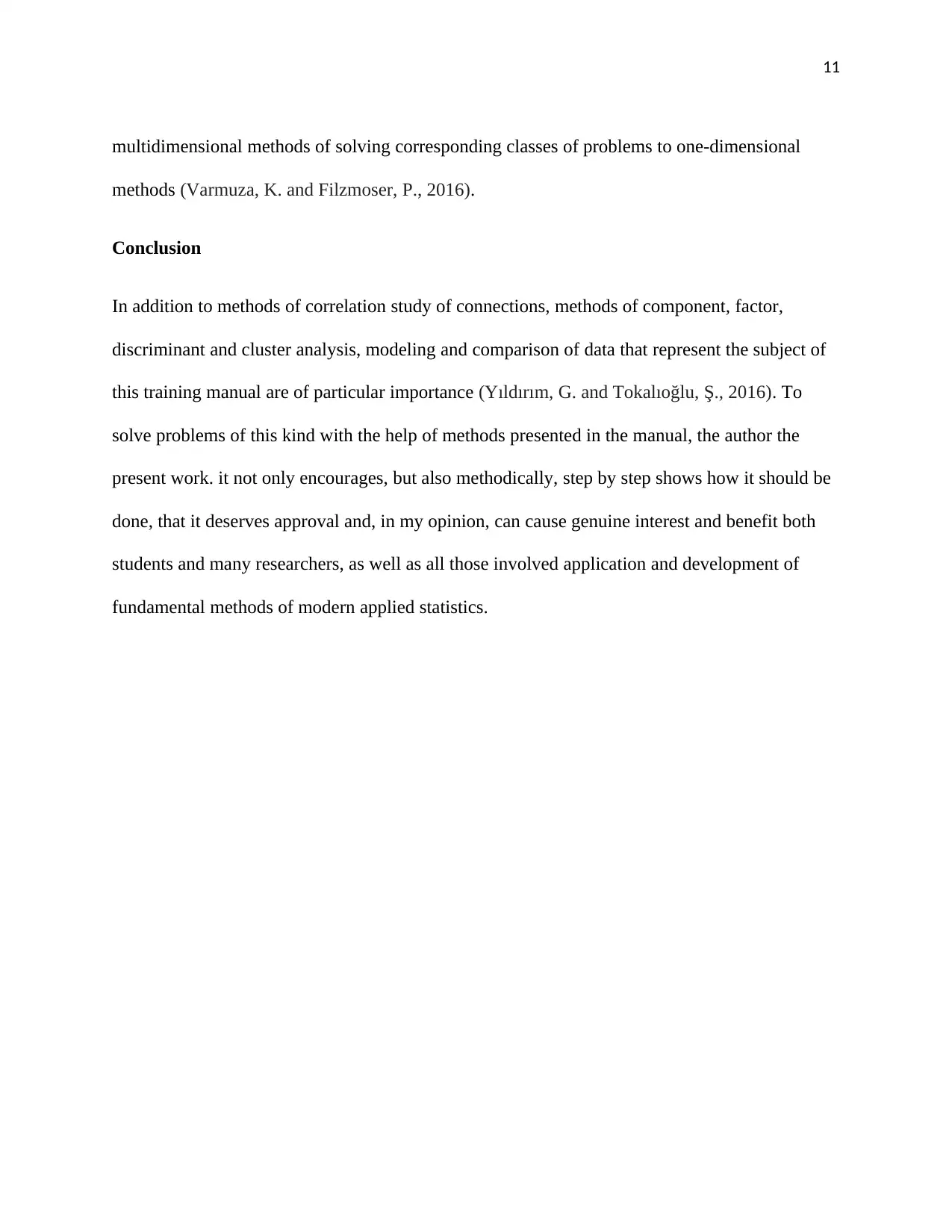
11
multidimensional methods of solving corresponding classes of problems to one-dimensional
methods (Varmuza, K. and Filzmoser, P., 2016).
Conclusion
In addition to methods of correlation study of connections, methods of component, factor,
discriminant and cluster analysis, modeling and comparison of data that represent the subject of
this training manual are of particular importance (Yıldırım, G. and Tokalıoğlu, Ş., 2016). To
solve problems of this kind with the help of methods presented in the manual, the author the
present work. it not only encourages, but also methodically, step by step shows how it should be
done, that it deserves approval and, in my opinion, can cause genuine interest and benefit both
students and many researchers, as well as all those involved application and development of
fundamental methods of modern applied statistics.
multidimensional methods of solving corresponding classes of problems to one-dimensional
methods (Varmuza, K. and Filzmoser, P., 2016).
Conclusion
In addition to methods of correlation study of connections, methods of component, factor,
discriminant and cluster analysis, modeling and comparison of data that represent the subject of
this training manual are of particular importance (Yıldırım, G. and Tokalıoğlu, Ş., 2016). To
solve problems of this kind with the help of methods presented in the manual, the author the
present work. it not only encourages, but also methodically, step by step shows how it should be
done, that it deserves approval and, in my opinion, can cause genuine interest and benefit both
students and many researchers, as well as all those involved application and development of
fundamental methods of modern applied statistics.
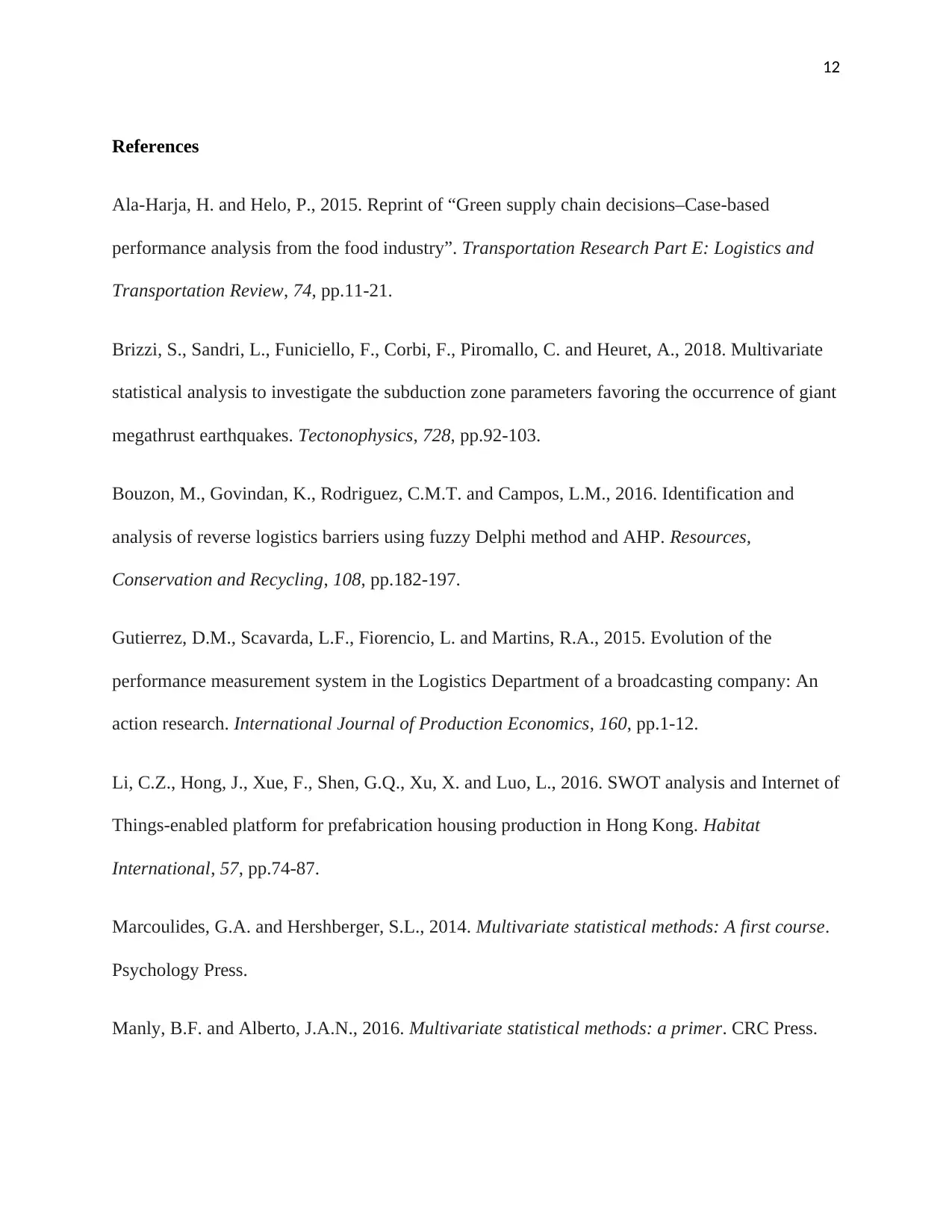
12
References
Ala-Harja, H. and Helo, P., 2015. Reprint of “Green supply chain decisions–Case-based
performance analysis from the food industry”. Transportation Research Part E: Logistics and
Transportation Review, 74, pp.11-21.
Brizzi, S., Sandri, L., Funiciello, F., Corbi, F., Piromallo, C. and Heuret, A., 2018. Multivariate
statistical analysis to investigate the subduction zone parameters favoring the occurrence of giant
megathrust earthquakes. Tectonophysics, 728, pp.92-103.
Bouzon, M., Govindan, K., Rodriguez, C.M.T. and Campos, L.M., 2016. Identification and
analysis of reverse logistics barriers using fuzzy Delphi method and AHP. Resources,
Conservation and Recycling, 108, pp.182-197.
Gutierrez, D.M., Scavarda, L.F., Fiorencio, L. and Martins, R.A., 2015. Evolution of the
performance measurement system in the Logistics Department of a broadcasting company: An
action research. International Journal of Production Economics, 160, pp.1-12.
Li, C.Z., Hong, J., Xue, F., Shen, G.Q., Xu, X. and Luo, L., 2016. SWOT analysis and Internet of
Things-enabled platform for prefabrication housing production in Hong Kong. Habitat
International, 57, pp.74-87.
Marcoulides, G.A. and Hershberger, S.L., 2014. Multivariate statistical methods: A first course.
Psychology Press.
Manly, B.F. and Alberto, J.A.N., 2016. Multivariate statistical methods: a primer. CRC Press.
References
Ala-Harja, H. and Helo, P., 2015. Reprint of “Green supply chain decisions–Case-based
performance analysis from the food industry”. Transportation Research Part E: Logistics and
Transportation Review, 74, pp.11-21.
Brizzi, S., Sandri, L., Funiciello, F., Corbi, F., Piromallo, C. and Heuret, A., 2018. Multivariate
statistical analysis to investigate the subduction zone parameters favoring the occurrence of giant
megathrust earthquakes. Tectonophysics, 728, pp.92-103.
Bouzon, M., Govindan, K., Rodriguez, C.M.T. and Campos, L.M., 2016. Identification and
analysis of reverse logistics barriers using fuzzy Delphi method and AHP. Resources,
Conservation and Recycling, 108, pp.182-197.
Gutierrez, D.M., Scavarda, L.F., Fiorencio, L. and Martins, R.A., 2015. Evolution of the
performance measurement system in the Logistics Department of a broadcasting company: An
action research. International Journal of Production Economics, 160, pp.1-12.
Li, C.Z., Hong, J., Xue, F., Shen, G.Q., Xu, X. and Luo, L., 2016. SWOT analysis and Internet of
Things-enabled platform for prefabrication housing production in Hong Kong. Habitat
International, 57, pp.74-87.
Marcoulides, G.A. and Hershberger, S.L., 2014. Multivariate statistical methods: A first course.
Psychology Press.
Manly, B.F. and Alberto, J.A.N., 2016. Multivariate statistical methods: a primer. CRC Press.
⊘ This is a preview!⊘
Do you want full access?
Subscribe today to unlock all pages.

Trusted by 1+ million students worldwide
1 out of 13
Related Documents
Your All-in-One AI-Powered Toolkit for Academic Success.
+13062052269
info@desklib.com
Available 24*7 on WhatsApp / Email
![[object Object]](/_next/static/media/star-bottom.7253800d.svg)
Unlock your academic potential
Copyright © 2020–2025 A2Z Services. All Rights Reserved. Developed and managed by ZUCOL.




